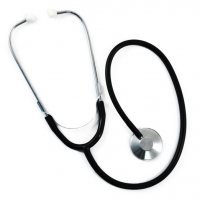








The stethoscope is an acoustic medical device for auscultation, or listening to the internal sounds of an animal or human body. It is often used to listen to lung and heart sounds. It is also used to listen to intestines and blood flow in arteries and veins. In combination with a sphygmomanometer, it is commonly used for measurements of blood pressure. Less commonly, "mechanic's stethoscopes" are used to listen to internal sounds made by machines, such as diagnosing a malfunctioning automobile engine by listening to the sounds of its internal parts. Stethoscopes can also be used to check scientific vacuum chambers for leaks, and for various other small-scale acoustic monitoring tasks. A stethoscope that intensifies auscultatory sounds is called phonendoscope.
Early History
The word stethoscope is derived from the two Greek words, stethos (chest) and scopos (examination). Apart from listening to the heart and chest sounds, it is also used to hear bowel sounds and blood flow noises in arteries and veins.
Since mankind first began to study human physiology, and the physical characteristics associated with various ailments, it has been obvious that the heart plays a crucial role in our bodies. The sounds it makes, as well as the sounds that the surrounding organs, such as the lungs, make can be crucial indicators when examining a patient. The act of listening to these sounds, known as auscultation, has been refined using even more powerful tools to aid physicians in this crucial examination.
In the early 1800’s, and prior to the development of the stethoscope, physicians would often perform physical examinations using techniques such as percussion and immediate auscultation. In immediate auscultation, physicians placed their ear directly on the patient to observe internal sounds.
This technique suffered from several drawbacks, the foremost being that it required physical contact between the physician and the patient and proper placement of the ear. In addition, the sounds observed by the physician were not amplified in any way, creating the possibility of missing key sounds that might indicate potential illness. Finally, the act of performing immediate auscultation could be awkward for both the physician and patient.
Throughout the 20th century many minor improvements were made to these iconic devices to reduce weight, improve acoustic quality, and filter out external noise to aid in the process of auscultation. Electronic versions of the stethoscope were introduced to further amplify sound. Stethoscopes are now available in a wide array of styles, with designs available for virtually every branch of medicine.
Despite all of the improvements and changes, the basic principle behind the stethoscope continues to remain the same; to provide physicians with the means to perform auscultation and identify specific sounds within the body.